SA Army Engineer Formation
 The South African Army Engineer Formation is to prepare and provide combat ready engineer forces for Chief of the SA Army to be integrated into landward defence capability to enhance mobility and survivability for own forces. The South African Army Engineer Formation is to prepare and provide combat ready forces to be integrated into the landward defence capability to enhance mobility and survivability of own forces.
The South African Army Engineer Formation is to prepare and provide combat ready engineer forces for Chief of the SA Army to be integrated into landward defence capability to enhance mobility and survivability for own forces. The South African Army Engineer Formation is to prepare and provide combat ready forces to be integrated into the landward defence capability to enhance mobility and survivability of own forces.
The South African Army Engineer Formation's core defence capability includes both the Regular Force and Reserves as an integral and essential part of the organisation. The "One Force Policy" provides for flexible utilisation of human resources and reduces the necessity to maintain a large and unaffordable Regular Force. Fair and equitable treatment is to be applied; all components render the same high standard of service, notwithstanding differences in dynamics, functioning and requirements of the two components. The role of the Public Service Act Personnel must also be recognised in line with the One Force Component and their contribution and development must be aligned with the policies and the output required from them.
The South African Army Engineer Formation will possess the minimum force level that can be maintained as a growth core, in accordance with the "Core Force Concept", without the permanent loss of capabilities. The reserves required for such expansion are treated as "One Force" with the permanent force. Predominantly Conventionally Oriented. The force design of the South African Army Engineer Formation will revolve mainly around the South African National Defence Force's primary function of defence against military aggression.
Possesses a Flexible and Rapid Response Capability. The South African Army Engineer Formation will possess a flexible and rapid response capability based on the landward defence capability strategy. Potential for rapid response and expansion for this conventional capability is contained in the Reserve component. The South African Army Engineer Formation must be able to use its collateral capability for certain secondary functions, such as peace support missions, humanitarian aid and internal deployment in support of Chief Joint Operations.
Military Engineers first made their appearance in South Africa during the Colonial Regime when in 1859 the Governor of the Cape Colony authorised the establishment of the Cape Engineers (Volunteers), which was comprised of South Africans and which in 1861 became simply the Cape Engineers . In 1865, the title was changed to the Cape Volunteer Engineer Corps, but in 1869, the Corps literally faded away. Ten years later in 1879, the Corps was resuscitated under the name Cape Town Volunteer Engineers. These sappers supported the ground forces during the Frontier Wars and even as far afield as Basutoland. The tasks they had to carry out were the normal duties carried out by sappers but by 1895, the sappers again disappeared from the scene.
It might be of interest to note that in 1879, the British defeated the Zulus, fresh from their triumph at Isanalwana, at Rorke's Drift, and that the young lieutenant in charge, who was awarded the Victoria Cross, was an Engineer Officer by the name of John Chard. The SA Defence Force has honored his memory by creating the awards of the John Chard Medal and John Chard Decoration, both awarded for long and efficient service.
In 1910, the Natal Engineer Corps was formed but ceased to exist in 1913, a year after the passing of the Defence Act in 1912. Just before the outbreak of World War I in 1914, the Cape Fortress Engineers were formed to relieve Imperial Troops occupied on sapper tasks in the fixed defences of the Cape Peninsula.
Although basically under the control of the Royal Engineers both in employment and training, the Engineer Units were composed of South Africans who were gaining valuable experience both in South West Africa and East Africa as also during World War I (1914 - 1919), and it was amongst these men that the seed was sown which has since flowered in the SA Army Engineer Corps with its superb achievements.
After World War I, all SA Army Engineer Units with the exception of the permanent Cape Fortress Engineers were disbanded. The SA Defence Act Amendment of 1922 made provision for a SA Army Engineer Corps among South Africa's new regular full-time forces, and in 1923 the Permanent Force element was established. By 1926, authority was granted in the GC and ACF Regulations for the Citizen Force Engineers. In 1933, due to the economic depression, the Permanent Force Engineers were disbanded leaving only the four original SA Army Engineer Corps Field Units in the ACF and in 1935, this number was increased to six. In 1938, the post of Staff Officer (Engineers) was created on the staff of the SA Army Training Section. At the same time, the number of SA Army Engineer Companies was increased to nine to serve the nine Infantry Brigades. In 1939, the post of Staff Officer (Engineers) was upgraded to Assistant Director of Training (Engineers) and in 1940 to Director of Engineers at Defence Headquarters. Also in 1939, the Engineer Training Centre was established at Zonderwater which was part of the military base established at Premier Mine. In 1949, the additional Directorates of Works, Fortifications and Coastal Works had been formed and also in 1949 the Railway & Harbours Brigade, which had been disbanded after World War I, was resuscitated.
During the period 1940 - 1945, the SA Army Engineer Corps which had started the war with a strength of 54 officers and 585 sappers, rose to the strength of approximately 16 000 men belonging to over 70 different companies or units. In the development of the Corps, three aspects of military engineering had to be considered and the obvious sapper groups were the Base, Lines of Communication and Field or Fighting Groups, each with its own particular tasks but motivated by the basic requirements of maintaining the mobility and comfort of the ground forces. Hence, the 70 different units covered the whole spectrum of military engineering, such as close support Field Companies and their Field Park Companies, Road Construction Companies, Railways, Harbours and Tunneling Companies, Survey Companies, Water Supply and Treatment Companies, Workshop and Engineer Stores Units and Chemical Warfare, Bomb Disposal and Camouflage Units, in all, 31 different functions and disciplines.
On 29 December 1944, in recognition of outstanding achievements by the SA Army Engineer Corps during World War II, His Majesty King George VI approved the design of our Corps emblem, a bursting grenade, to be a device of 9 flames instead of the original seven, and authorised the use of the motto "Ubique", meaning "Everywhere". This is the same as that of the Corps of Royal Engineers and has been incorporated in the cap badge.
With the end of the war in 1945, the SA Army Engineer Corps disappeared from the military scene, and only a Junior SA Army Engineer Corps Regular Force Officer was appointed on the staff of the Director of Military Training. However, with demobilisation, 16 Field Squadron was resuscitated to accommodate sappers wishing to remain in the Regular Force. In 1946, a GSO2 Engineers was appointed with two other Regular Force Officers and an Engineer Training Wing was established at what was then the Military College, now the SA Army College. The two posts were both held by one officer, a most inconvenient situation, and it was not until 1964 that the post of GSO2 Engineers was filled full-time by a Regular Force Officer. In 1948, the Wing was moved to Potchefstroom, where it became the Engineer Wing of the SA Army Artillery and SA Army Armour School. In 1968, it was transferred to Kroonstad as the Engineer Training Centre and finally in 1969 became the School of Engineers.
Meanwhile in 1957, the Mobile Battalion was established, which later in 1959 became the Mobile Watch, and after going through various changes in 1964 eventually became 1 Composite Construction Regiment and in 1967, 1 Construction Regiment, which was also disbanded in 1968. In 1969, the Directorate of Engineers was established at Kroonstad, but in 1972 it was moved to SA Army Headquarters, Pretoria where it was developed to what it is today.
In 1968, the 35 Field Park Squadron was established as a Regular Force Unit and in 1974 was renamed 35 Engineer Support Unit and stationed at Kroonstad. In 1975, the South West Africa Engineer Support Unit was formed and stationed at Grootfontein. Also in 1975, arising out of all the Survey and Printing activities of the Survey and Printing Units of World War II, the 47 Survey Squadron, a Regular Force Unit, was formed. This Unit trained all the National Servicemen posted to it and in turn fed the two DF Survey Units which had been established - the 46 Survey Squadron at Cape Town in 1959 and the 45 Survey Squadron at Pietermaritzburg in 1969.
Meanwhile in 1946, the ACF Engineers were resuscitated and 1 Field Engineer Regiment was formed to be followed by 2 Field Engineer Regiment. In 1958, 2 Field Engineer Regiment was disbanded but to meet the demands of the South African Defence Force, further squadrons were formed. In 1973, 1 Field Engineer Regiment was disbanded and the Squadrons attached to various formations. With the development of the SA Defence Force to meet both the internal and external threat, Field Engineer Units were created to support the new organisations.
In 1962, the Regular Force was formed and 17 Field Squadron was created to support this force, stationed in Potchefstroom. However, in 1967 it was moved to Bethlehem and became a purely training unit. In 1974, it became the two new squadrons 24 and 25 Field Squadrons as support squadrons in the operational area of South West Africa.
1 Construction Regiment was re-established at the end of 1976 at Marievale near Springs, Gauteng and towards the end of 1977 was tasked with the construction of the Military Base at Dukuduku on the Natal North Coast. Subsequently, due to policy changes, its activities were confined to the operational area, in support of the SA Army, with great success.
In 1982, the SA Army Engineer Formation was created with the Directorate of Engineers as its Headquarters and commanded by the Director of Engineers which gave the Directorate operational control over most of its Engineer Units. During this time, control of the School of Engineers passed to the Director of Training, so did all Corps Schools. In 1983, ministerial authority was obtained for the conversion of all Field Squadrons, normally attached to the conventional forces, to Field Engineer Regiments, each comprising a headquarters, 2 field squadrons and a support squadron. Each squadron has 3 troops. This did not affect Engineer Squadrons attached to the territorial commands for counter-insurgency operations.
The main functions of the Sapper are to ensure the mobility of the fighting men both in the advance and retreat, to make life as secure and comfortable as possible for them, in order to maintain their morale and hence their fighting ability, and whose duties often go far beyond that which is expected from the normal field engineer. In addition, he must possess enough initiative, experience and imagination to deny these necessities of modern warfare to the enemy.

|
NEWSLETTER
|
| Join the GlobalSecurity.org mailing list |
|
|
|

